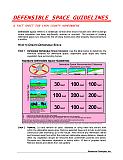Appendix E - Homeowner Guidelines
Homeowner Guidelines
Defensible Space Guidelines
Download the Defensible Space Guidelines fact sheet for Lyon County

(PDF, 148kb, 2 pages)
Homeowner’s Annual Checklist
Download the Homeowner’s Annual Checklist fact sheet for Lyon County

(PDF, 26kb, 1 page)
Fuelbreaks and Fuel Reduction Treatments
Download the Fuelbreaks and Fuel Reduction Treatments fact sheet for Lyon County

(PDF, 62kb, 1 pages)
Revegetation Specifications for Fuels Reduction Areas - Mound House
| Common Name | Scientific Name | Seeding Rate (PLS pounds/acre) |
|---|---|---|
| Bottlebrush squirreltail | Elymus elymoides | 3 |
| ‘Vavilov’ Siberian wheatgrass | Agropyron fragil. ssp. sibericu | 3 |
| ‘Ephraim’ Crested wheatgrass | Agropyron cristatum | 3 |
| “Immigrant” Forage Kochia | Kochia prostrata | 1.5 |
| TOTAL PLS POUNDS PER ACRE | 10.5 | |
Revegetation Specifications for Fuels Reduction Areas - Smith Valley
| Common Name | Scientific Name | Seeding Rate (PLS pounds/acre) |
|---|---|---|
| Bottlebrush squirreltail | Elymus elymoides | 2 |
| “Sodar” Streambank wheatgrass | Elymus lanceolatus ssp. psammophilus | 4 |
| Indian ricegrass | Achnatherum hymenoide | 2 |
| “Immigrant” Forage Kochia | Kochia prostrata | 2 |
| TOTAL PLS POUNDS PER ACRE | 10.0 | |
These seed mixtures are for treating all disturbed areas and areas treated for fuel reduction purposes. All seeds should be thoroughly mixed and seeded together at the same time. Drill seeding is recommended where feasible. Drill rows should be spaced 12 inches apart and seed should be planted at a depth of 1/2 inch. Broadcast seeding at twice the application rate is recommended for rocky, steep, or small treatment areas. The seed can be broadcast using hand held seeders such as a “Whirlybird” or a broadcast seeder mounted on a quad-runner. Continually mix the seed while seeding to equally distribute the small seeds throughout the mix. Following the seed application, seeded areas should be lightly raked to assure seed placement at an average depth of 1/2 inch. This can be done with hand held rakes, or by pulling a drag or piece of chain link fence behind a truck or quad-runner in areas where less stones are on the surface.
These guidelines are provided as overall recommendations. However, site-specific evaluation of the treatment areas by a specialist from a land management agency, the Natural Resources Conservation Service, or the University of Nevada Cooperative Extension will provide even greater assurance for success.
